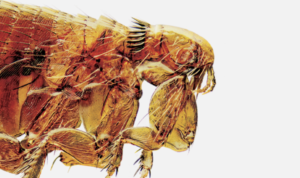WHAT IS FLEA-BORNE TYPHUS?
Flea-borne typhus is a disease transmitted to humans by fleas infected with the bacteria Rickettsia typhi or Rickettsia felis. This disease is reported to occur worldwide. In the United States, most cases occur in Texas, California and Hawaii with an average of about 200 cases every year.
THE DTLA SITUATION?
Although flea-borne typhus is endemic (always present) in Los Angeles county, the number of reported cases has been on the rise. Between July 2018 to September 2018, the Los Angeles County Department of Public Health (LACDPH) identified 9 cases of flea-borne typhus in DTLA. This was a large enough cluster in small enough area to launch a health alert from the LACDPH. All 9 cases had a history of living or working in DTLA and 6 of the 9 cases involved homelessness or interim housing living conditions. All nine cases were hospitalized. Outbreaks have also been identified in Long Beach and Pasadena. No deaths from flea-borne typhus have been reported to date of this blog’s publication.
HOW?
Humans become infected with flea-borne typhus by coming into contact with an infected flea. The most common type of fleas that carry typhus are the cat flea and rat flea. (Remember that when dogs have fleas, they are usually cat fleas!) The flea carries the Rickettsial bacteria and spreads it to humans through flea bites or by infected flea feces entering a wound on human skin. This is not a disease that is contagious between people - it is caused by exposure to infected fleas.
SIGNS?
Flea-borne typhus does not cause disease in dogs and cats like it does humans. Most likely your pet will not become sick after exposure to Rickettsia typhi or Rickettsia felis. Human illness is the greater concern, especially in those with compromised immune systems. Signs of flea-borne typhus in people include skin rashes and flu-like signs. These symptoms can pass on their own but may also require hospitalization. In severe cases people can develop liver, kidney, heart, lung, brain or other neurologic problems as a result of flea-borne typhus.
PREVENTION?
Avoid exposure to wild or stray animals. Do not leave pet food outdoors. Keep your yard free of debris and trim overgrown plants and bushes. Keep garbage containers tightly covered to avoid attracting animals. Wear gloves and a mask when cleaning these areas and wash your hands when you are finished.
If you think you have a flea problem in your home, vacuum daily paying special attention to upholstery and carpets. Wash all bedding in hot soapy water and dry in hot heat. If you have an infestation, it may be best to just discard old pet bedding and replace it once the infestation is controlled.
Most importantly, keep your pet from being a cozy home for fleas: flea control, flea control, flea control! This is the best way to limit your own exposure to flea-born typhus. Adulticides control adult fleas and insect growth regulators render flea eggs non-viable. Targeting fleas at different life stages not only prevents infestations but also protects you from exposure to flea bites and flea-borne typhus. Schedule an appointment with us to discuss which specific parasite prevention is best for your pet.
MORE INFO?
Visit the U.S. Centers for Disease Control and Prevention typhus website: https://www.cdc.gov/typhus/index.html
Visit the Los Angeles County Department of Public Health Flea-Borne Typhus website: https://www.publichealth.lacounty/gov/acd/VectorTyphus.html
